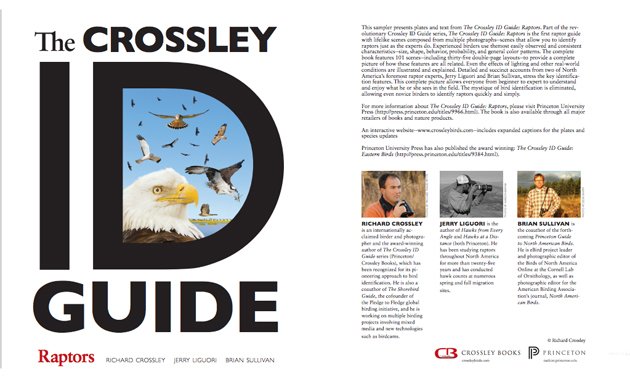
What is it about raptors that fascinates so many people?
My work colleague Jim stops me at least once a week in the hallway to ask, “See any interesting hawks lately?” Sometimes, I’ll reply with a story about the sparrows found in a local grasslands preserve. Or, I’ll wax poetic over a Hooded Warbler. But no, Jim’s eyes only light up when I talk about the Red-tailed Hawk that observes feeder birds from the top of the pine tree behind our building, or the Northern Harriers that in fall kettle over that grasslands preserve. And, he’s not the only one. I haven’t done any surveys, but I would bet my binoculars that images and stories of hawks attract more attention and adoration from birders and the average person on the street than any other bird family. As much as we love warblers, tiny songbirds are not the focus of dozens of birdcams located across the country. Those cameras are aimed at hawks. Families do not hike up mountains to sit all day on pointy rocks to watch woodpeckers. It’s hawks they pant and wait to see. And, a shorebird is not the image leading off the introduction to The Colbert Report. It’s a Bald Eagle, a hawk.
I’m not going to try to explain why people are fascinated by hawks; human-to-avian psychology is not my specialty. I started thinking about this because I was pondering the number of books published about hawks and hawk identification. In the past two years, our bookshelves have welcomed Jerry Liguori’s Hawks At A Distance (2011), the second edition of the classic Hawks in Flight (Dunne, Sutton, Sibley; Houghton Mifflin Harcourt, 2012), and Chris Earley’s updated edition of the excellent regional guide, Hawks and Owls of Eastern North America (2012). Add to that Liguori’s earlier Hawks From Every Angle (2005), the entry from the Peterson Field Guide series, Hawks of North America, second edition, by William S. Clark and Brian K. Wheeler (Houghton Mifflin, 2001), and A Photographic Guide to North American Raptors (Wheeler and Clark, Princeton University Press, 2003), and you have a whole lot of excellent hawk identification books and field guides.
And now we can add The Crossley ID Guide: Raptors, the latest volume in what promises to be an interesting series from Crossley Books and Princeton University Press. The first Crossley book, The Crossley ID Guide: Eastern Birds (2011), ignited passionate discussions about the best way to learn about birds in the field and at home, and about the differences between a field guide and an identification guide. One thing everyone agreed on was that Crossley’s photographs were very different from those in your grandmother’s field guide. The publication of this new title is again an occasion for excitement (how can you can you not get excited when looking at photographic layouts like the one of Bald Eagles shown above?) and an opportunity for discussion: What do we, as birders, want from a hawk identification guide? And, how does this title add to the wealth of identification knowledge we already have available?
Let’s take a look at the book itself. Raptors (as I’m going to call the book) continues the unique Crossley method of presenting multiple bird images of a species, 8 to 25 photographs, in a one or two-page plate, with a background representative of the species’ typical habitat. The idea, as Crossley explains in the Preface, is to present the birds as they are seen in the field, allowing you to “enjoy the beauty of the outdoors and birds from an armchair” while practicing bird identification and training the eye to see details and shapes. The photograph above, of accipiters seen at a hawkwatch, gives a good idea of the type of photographic plate you’ll find in Raptors. The photograph is a technological product, of course, the result of many photographic images combined. But, the feeling behind it, of people filled with joy at the sight of hawks all around them, on top of a mountain on a beautiful spring day, is authentic. Other photographs present hawks sitting and flying over wintery fields, through utility cuts, over redrock western mesas, and even against a background of skyscrapers (I’m not sure which city, sadly, in most cases the actual sites of these impressive backgrounds are not identified.) In all plates, the birds are shown in close-up and far away, sometimes perched, sometimes engaged in behavior, and always at every angle possible, from below and above, from the side, and in silhouette. A quick comparison of how raptor species are depicted in Eastern Birds as compared to the photographic images in Raptors shows that each title has unique images.
The big difference between the Eastern Birds volume and the Raptors volume is, of course, that there are over 640 eastern species and only 34 raptor species. Crossley has taken advantage of this by greatly expanding the text, smartly bringing in Jerry Liguori and Brian Sullivan as co-authors. The book is divided into two major sections: Images and Accounts. He has also added “mystery photo pages”, layouts in which species or the age and sex of a specific species are not identified, with full descriptive answers in the back of the book. The hawk watch photo above is an example of the mystery pages and one of the best, asking the reader to identify and age “as many of the Sharpies and Coops as you can!” (The version of the photo in the book does number the birds, very helpful when you look up the answers.) The book thus carves out a unique niche amongst hawk identification books, that of an identification tool that teaches as you read, that creates opportunities for interactive learning as a part of the identification and reference process. Very sneaky, Richard! And, quite enjoyable. (To be fair, Crossley does make clear in the Preface that the design of the book is based on cognitive learning processes. So, the learning part will only be a sneaky surprise to birders who don’t read that section. Or this review. )
The learning process starts with the inner cover, which shows all hawk species in size proportion, all facing left, with text identifying them by 4-letter bander’s code, size (length and wing span), and the page numbers for the specie’s plates within the book. This quick reference echoes the inner front and back covers of Hawks in Flight, which presents drawings of hawk species in flight facing right, with simple name identification. The Introduction succinctly describes the basic concepts of migration and molt and summarizes raptor families: vultures, eagles, osprey, buteos, accipiters, harriers, kites, falcons. A two-page section on Raptor Topography identifies the parts of a hawk’s body and feathers on three images of hawks perched, in flight from the underside, and in flight looking from the side. Skipping to the back of the book, a one-page Glossary briefly defines terms such as axillaries (wing pits) and stoop (to dive with wings folded). The Index is elementary, with references to text and images by common and scientific name; subspecies and morphs such as Krider’s Hawk are not included. The inner back cover is a geological map of North America (knowing about hawks involves knowing where the mountains are located), with a second inset map showing the keys to the migration maps included in the species accounts.
Thirty-four species of hawks are covered in the book. It includes the hawks we all know and love (Red-tailed Hawk, Cooper’s Hawk, Peregrine Falcon, Bald Eagle, you know the drill), and species found only in western or southern regions (Zone-tailed Hawk, Prairie Falcon, Crested Caracara, etc.). It does not include vagrants such as Roadside Hawk and Eurasian Hobby; the only major hawk guide in print covering these species is Peterson’s Hawks of North America. Owls are not covered and I had to think about that. To me, the term “raptor” includes owls. The Oxford English Dictionary defines “raptor” as “bird of prey”, derived from the classical Latin work raptor, which means plunderer. The Merriam-Webster Dictionary says it comes from the Latin term raptare, “seize and carry off”. I’m sure there is a whole article that could be written about “raptor”, how it was used historically, and whether or not owls are raptors, and if the term “diurnal raptor” would be more appropriate. But the bottom line for this review is that in The Crossley ID Guide: Raptors the term is used interchangeably with “hawk”. Perhaps there is a Crossley ID Guide to owls in the future?
The Crossley ID Guide: Eastern Birds allocated, at the most, one page to each raptor species; some regional species like Zone-tailed Hawk got only one-quarter of a page. The Crossley ID Guide: Raptors has the luxury of much more space and uses it to illustrate aspects of hawk identification beyond distinguishing field marks. Ospreys, for example. The first two Osprey plates in the book illustrate adult and juvenile Ospreys, sitting and in flight, up close and in M-shaped silhouette, on a platform in the marsh and soaring over the marsh with a huge fish in its talons. This is what we expect. But, wait, there’s more! The next 2-page plate, shown above, illustrates “Osprey behavior”, the graceful yet powerful way in which an Osprey dives into the water and catches its fish, shaking water off as it emerges and then flies away with its dinner held head-first, aerodynamically aligned with its body. If you’ve seen this in person, you know how exciting it can be. But, if you’ve never had an Osprey encounter, studying this photograph and its text prepares you for what to expect (especially important for bird photographers) and gives the background facts, such as the rough spines on the bottom of Osprey’s feet that help them hang onto their fish, that helps you appreciate the experience.
In addition to behavior, the plates illustrate identification challenges such as the effect of light (sunrise, looking into the sun, a white sky), similarly sized perched buteos, a sky full of dark raptors, and hawks flying away from you. Full attention is given to geographic morphs. Red-tailed Hawks win the prize in this category, with 10 pages devoted to the hawk in the East, the West (photo above), Krider’s and Harlan’s variants, and the mix of races found on the Prairies and on the Southern Great Plans. Most of the Red-tailed Hawk plates are spread out over two pages, giving the photos a largeness of scope that was missing from the Eastern Birds volume, where birds often seemed squeezed together tightly. Most of the common hawk species are covered in four or six pages, and the regional species are allocated two pages.
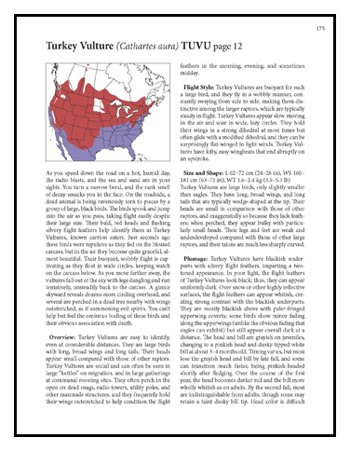 As in Eastern Birds, text at the bottom of the Image pages tell us the common and scientific names of the bird, the 4-letter banding code, length, wing spread, weight and a summary of the bird’s appearance, habitat, distinguishing field marks, flight pattern, sex and age differences in size and plumage. And, again, something more, the page number for an expanded Species Account. The Accounts take up about one-half of the book, with about two pages for each species (Red-tailed Hawk, six pages). They are a great addition. Each account starts off with a mini-essay, ranging from one to three paragraphs, depicting the personality of the bird. Some of these, such as a birder’s experience finding White-tailed Hawks by driving towards the smoke plumes of a local fire, are charming. Others, particularly the stories told from the bird’s point of view, did not appeal to me, but I think this is a totally subjective opinion. I just happen not to enjoy anthropomorphic bird essays. More importantly, the Accounts include a wealth of information on each species: a migration map showing regular breeding range, regular year-round range, and regular winter range, an Overview, sections on Flight Style, Size and Shape, Plumage, Geographic Variation, Molt, Similar Species, Status and Distribution, Migration, and Vocalization. They expand the scope of the condensed text in the Images section, and make The Crossley ID Guide: Raptors into a reference tool that stands on its own, in the Crossley mold, but a different book from The Crossley ID Guide: Eastern Birds.
As in Eastern Birds, text at the bottom of the Image pages tell us the common and scientific names of the bird, the 4-letter banding code, length, wing spread, weight and a summary of the bird’s appearance, habitat, distinguishing field marks, flight pattern, sex and age differences in size and plumage. And, again, something more, the page number for an expanded Species Account. The Accounts take up about one-half of the book, with about two pages for each species (Red-tailed Hawk, six pages). They are a great addition. Each account starts off with a mini-essay, ranging from one to three paragraphs, depicting the personality of the bird. Some of these, such as a birder’s experience finding White-tailed Hawks by driving towards the smoke plumes of a local fire, are charming. Others, particularly the stories told from the bird’s point of view, did not appeal to me, but I think this is a totally subjective opinion. I just happen not to enjoy anthropomorphic bird essays. More importantly, the Accounts include a wealth of information on each species: a migration map showing regular breeding range, regular year-round range, and regular winter range, an Overview, sections on Flight Style, Size and Shape, Plumage, Geographic Variation, Molt, Similar Species, Status and Distribution, Migration, and Vocalization. They expand the scope of the condensed text in the Images section, and make The Crossley ID Guide: Raptors into a reference tool that stands on its own, in the Crossley mold, but a different book from The Crossley ID Guide: Eastern Birds.
The Accounts are largely written, according to the Preface, by Jerry Liguori and Brian Sullivan, and, as I said in the beginning of this review, better raptor experts could not have been found. Jerry Liguori, the author of Hawks From Every Angle and Hawks At a Distance, as well as numerous articles, has been studying raptor biology and identification since 1984, including stints at major hawk migration counts. He claims on his web site that “I was hooked on raptors the moment I laid eyes on a Turkey Vulture in 1983”. Brian Sullivan is known as the Cornell Lab of Ornithology eBird project leader; he is also the photographic editor of the Birds of North America Online, photographic editor for the ABA journal North American Birds, and co-author of the forthcoming Princeton Guide to North American Birds.
Liguori and Sullivan also contributed photographs to Raptors, but, as Sullivan makes clear in an interview on the blog Thermal Birding, Richard Crossley is the mastermind behind the creation of the image plates and the visual concept behind the Crossley ID guides, as well as the photographer responsible for most of the book’s images. The British-born Crossley is co-author of The Shorebird Guide and, more recently, a co-founder of the Pledge to Fledge Global Birding Initiative. I was joking (sort of) when I asked if an owl title was in the works, but an interview with Crossley on the Princeton University Press blog indicates that I did have the right idea. A Crossley ID Guide to birds of Britain and Ireland is due out this fall, to be followed by a guide to Waterfowl and, finally, the ID Guide to western birds.
I posed two questions at the start of this review: What do we want from a hawk identification guide? And, how does The Crossley ID Guide: Raptors add to the wealth of identification knowledge we already have available? I think I’ve answered the second question. The Raptors guide, while not a field guide , is a learning and reference resource that fills a niche surprisingly untouched by previous guides. The mystery photos, rooted in the Shorebird Guide quiz questions and the popular American Birding Association photo quizzes, are an excellent self-learning tool. Try your hand at the photo above,of Raptors Topside (answers in the book, but here’s a clue: nine species are represented). The quizzes may not always give you the answer you want. There are times when you just cannot identify a bird, or age a species, and a couple of the answers to the mystery photos say just that.
In addition to its educational component, Raptors covers sitting hawks, making it one of the two major hawk guides t0 depict and describe raptors not in flight. Raptors is in many ways comparable to Hawks of North America, which is also divided into two sections, and which contains extensive information about plumage by sex and age, flight, molt, and behavior, as well as length and wingspread measurements by sex. The big difference is that the Peterson title is a field guide, made for carrying around in one’s pocket in the field, and that it adhere’s to the Peterson tradition, of birds illustrated with arrows pointing to important field marks. Crossley rejects the arrows. Like Lillian and Donald Stokes, who in their latest field guides state it is more important to see the whole bird, Crossley writes in the Preface, “it is time to move on from highlighting a few plumage marks with arrows as these are just a small part of the whole picture–at best!” I don’t agree. I like the arrows; I think they serve a purpose. The arrows were an important factor in the revolutionary popularity of the original Peterson field guides, and I don’t see any reason that they should not work for beginning birders today as they did in the mid-twentieth century.
Arrows do have their limits. Once a birder learns the important field marks, Crossley is right, it is time to go on to learning size and shape and flight pattern. This is particularly true for identifying hawks, who are often not close enough to see the pattern on the flight feathers or the contrast of the crown with the nape. Raptors’ plates can seem overwhelming, especially when seen for the first time. This is a book that requires patience and attention, traits a birder also needs out in the field. And, while the Liguori and Peterson hawk identification guides are probably most helpful in identifying a specific bird you have seen and photographed in the field, I think The Crossley ID Guide: Raptors is the book that will bring the biggest payoff in terms of increasing overall level of hawk expertise. Its main rival in this area is Hawks in Flight. Which one to choose?
There is no easy answer. I think this is a matter of personal preference. Birders who gravitate to traditional print guides will probably feel more comfortable with Hawks in Flight. Experienced birders who enjoy learning visually and who look at photographs like the one above and say, “Wow! I can’t wait to figure out which of these Northern Harriers are males and females, which are adults and which are juvvies,” should make the investment in The Crossley ID Guide: Raptors.
So, what do we want from a hawk identification guide? Like the commercial says, we want more. We want countless images, plumage descriptions detailed to the texture of the last tertiary feather, behavior patterns that can serve as clues. We want to know how to distinguish a Prairie Falcon from a Peregrine Falcon, a Sharpie from a Coops, that dot in the air to the east from that v-shape in the air flying in from the northeast. We want to know the hawk so well that when we see it from the car window, its name comes rolling off our tongues, and we feel something of its power. Hawks are magic. Hawk identification guides are a bridge to their magic. Crossly, Liguori, and Sullivan have created a bridge that is visually different, a brilliant span of color and shapes, and they’ve grounded it with supports made of hard textual facts. It is a bridge worth trying. I look forward to hearing about your experiences with the Crossley ID Guides, both for Eastern Birds and Raptors. And, to reading about what you think is the most important element in a hawk identification guide.
——————————————-
Images provided by and used with permission of Princeton University Press.
The Crossley ID Guide: Raptors
by Richard Crossley, Jerry Liguori & Brian Sullivan.
Princeton University Press, 2013.
304 pp. | 7 1/2 x 10 | 101 color plates. 34 color maps.
ISBN: 9780691157405.
$29.95, with discounts from the usual suspects


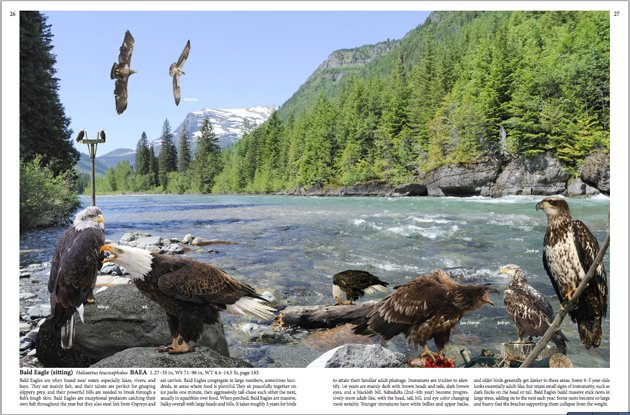
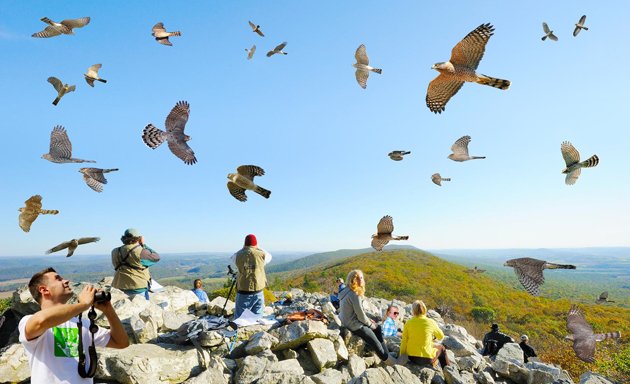

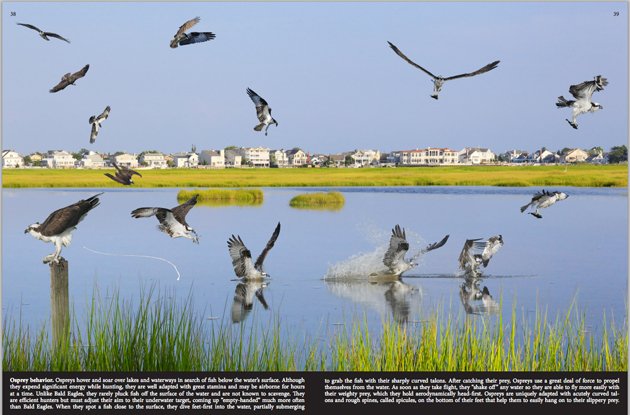
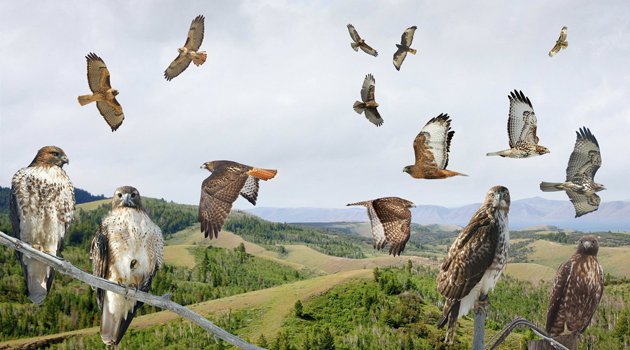
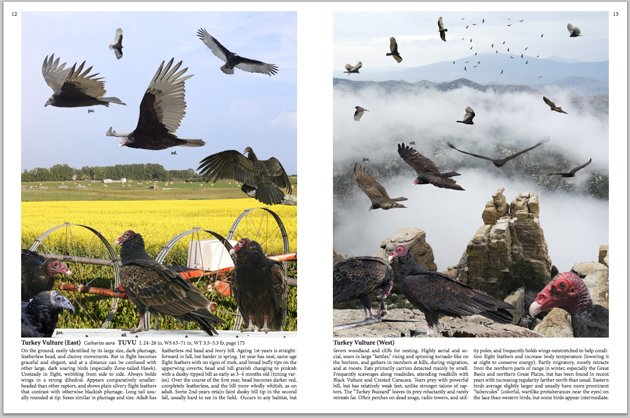
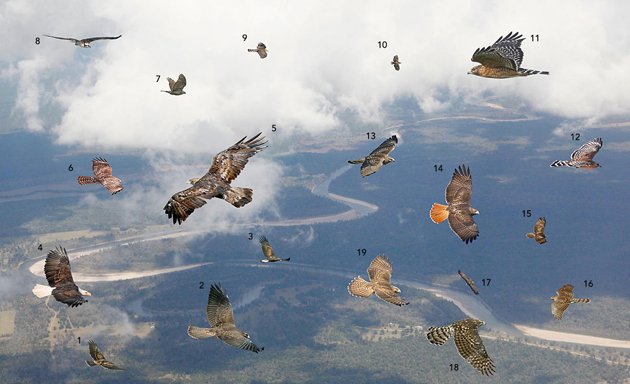
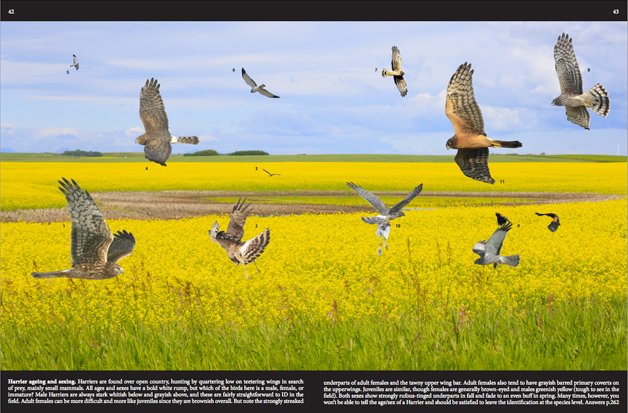











Wow! This is a long review. You make me think about what kind of book I want to buy for fall hawk watching. The photos are awesome. I”m leaning towards this book, the Crossley Guide. Worth it just for the photos, like you say. Thanks.